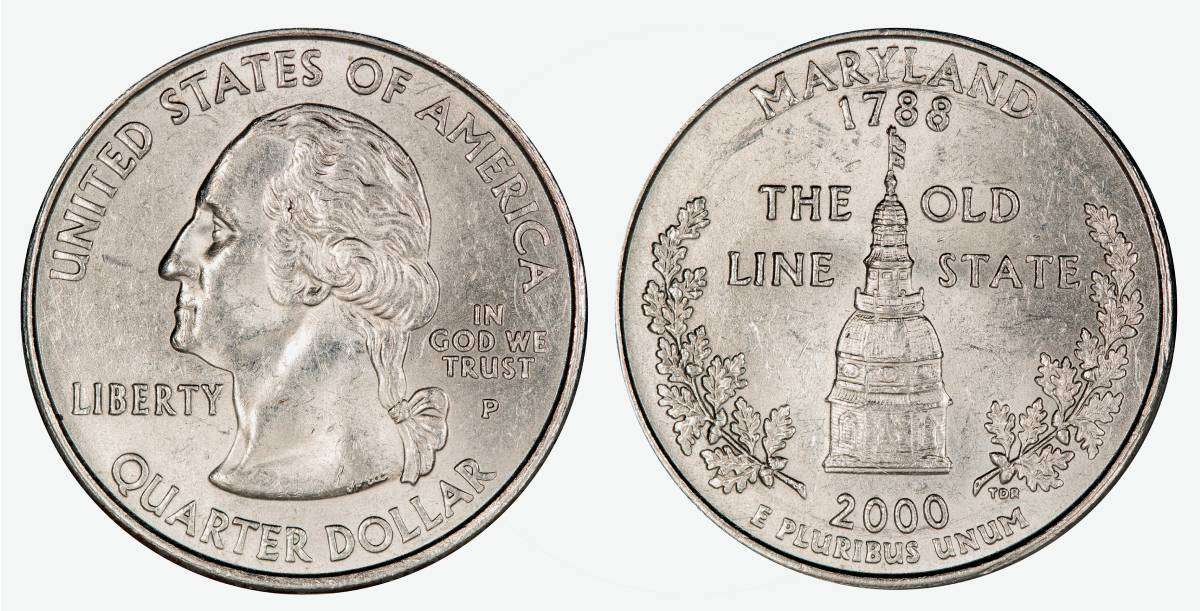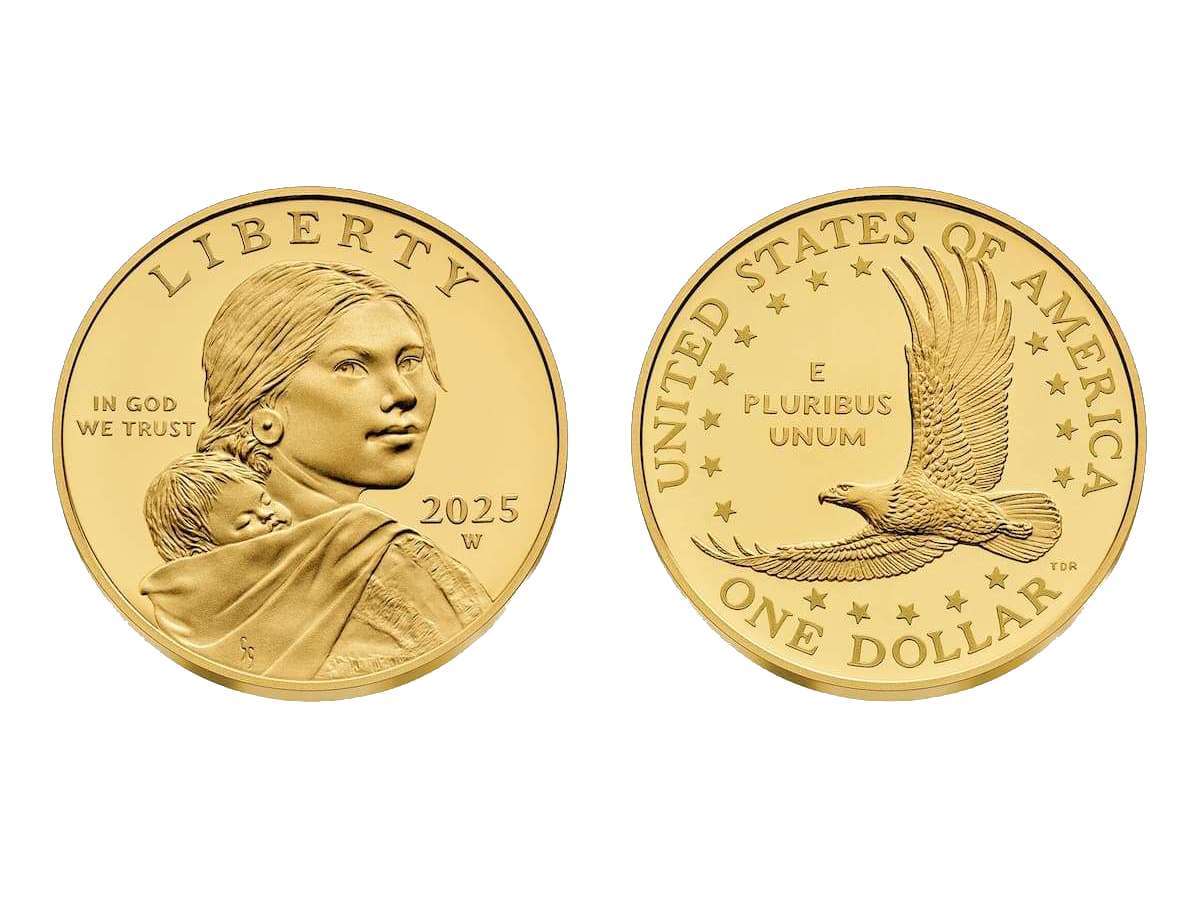Do you have any 2000 Maryland quarters?

Some have errors and varieties that are worth a lot of money!
I’m going to help you determine if your Maryland state quarters are worth more than face value, and I’ll be answering the following questions:
- Which Maryland quarters are worth keeping?
- What are some valuable errors that can be found on Maryland state quarters?
- How much is a regular Maryland quarter worth?
So, let’s get to it. Here’s everything you need to know about Maryland quarters…
FUN FACT: What’s up with the 1788 date on the coin? That’s the year Maryland was admitted to the Union!
Valuable Errors To Look For On Maryland Quarters
There are many kinds of state quarter errors that you can find in circulation.
So you’ve got to check your change carefully!
Look for these types of errors:
#1 – A Maryland Quarter With Overlapping Words Or Images
Sometimes, when a coin die is created, the hub will accidentally create two images on the coin. This will usually appear as a slight, overlapping misalignment of the same design twice on part of the coin. The doubling can be quite extreme or barely noticeable. Coin collectors are always on the lookout for doubled die coins!
There aren’t any major known doubled dies among the 2000 Maryland state quarters. But if there is a doubled die yet to be found, somebody has to find it… and it might as well be you!
It’s tough to say how much one is worth, since there’s no market data yet for Maryland doubled die quarters if they exist. But other state quarter doubled dies are worth more than $100 apiece! So, it’s definitely worthwhile to look for one.
#2 – A Maryland Quarter That Appears Off-Center
When a die doesn’t strike the design squarely onto the blank coin, as should normally happen, then the result is a coin that’s missing part of its design. Such off-center strikes are scarce. The rarest are those in which most of the design is missing, yet the entire date is still fully visible.
Maryland quarters with off-center errors are really hard to find, and most are pretty valuable:
- A quarter that is 5% to 10% off is worth $10 to $20.
- One that is 20% to 40% off ranges in value from $20 to $100.
- Coins that are 50% or more off center usually trade for more than $100.
#3 – A Maryland Quarter With Raised Lines On It
What happens when coin dies get old? They start to crack. And when they crack in operation, the crevices in the die leave raised lines behind on the finished coin. As die cracks progress in size, so does the appearance of the resultant raised lines left behind on the coins struck by the damaged dies.
Some of these die cracks (or die breaks) are small and relatively insignificant. Others are huge — running clear across the coin. In some cases, they create funny-looking new images on coins — such as the die crack on the Delaware quarter that runs from the mouth of the horse on the coin’s reverse (tails side) down, making the horse appear as though it’s spitting! The Spitting Horse Delaware quarter is worth $100 or more.
Are there any amazing die cracks to find among Maryland state quarters?
There are reports of some minor die cracks on Maryland quarters involving either the obverse (heads side) or reverse. These are generally worth between $5 and $15. But so far, there are no known die breaks on Maryland quarters quite as prominent or sought-after by collectors as that seen on the Delaware Spitting Horse quarter.
#4 – A Maryland Quarter That Is Flatter And Wider Than Normal
When a coin is created, it’s normally struck inside of a device called a retaining collar. This not only helps keep the coin centered, but it also helps form the rim of the coin. On quarters, retaining collars help imprint those little vertical lines you see on the edge of the coin. (These lines are called reeds.)
What happens when a quarter is not struck inside the retaining collar? It’s struck flatter and wider than normal, and the reeds will not be stamped into the edge of the coin. These are called broadstruck coins — such errors are both rare and valuable.
To determine if you have a broadstruck quarter or not, you’ll want to look for the following features. Broadstruck quarters:
- Don’t have a fully struck rim
- Don’t have their reeded edges
- Are thinner than normal quarters
- Are wider than normal quarters
How much is a broadstruck Maryland quarter worth? That largely depends on the condition of the coin, but it could be worth between $25 and $100.
How Much Are Regular Maryland Quarters Worth?
What if you’ve found a 2000 Maryland quarter in your pocket change and it doesn’t appear to have any errors or anything else unusual about it? How much is it worth then?

Any 2000 Maryland quarters with “P” or “D” mintmarks that you find in circulation are worth their face value of 25 cents.
I know, I know… Not the news you’re looking for I’m sure. But, unless a Maryland state quarter with a “P” or “D” is in mint condition (never spent as money and has no wear), then it’s not going to be worth any more than its face value.
The reason is more than 1 billion Maryland quarters were struck in 2000 — 1,234,732,000 business-strikes, to be exact. And that’s a lot of quarters!
Here’s how many Maryland quarters were made at each US Mint facility:
- Philadelphia — 678,200,000
- Denver — 556,532,000
And we can’t forget the proof coins that were made at the San Francisco Mint:
- 2000-S copper-nickel clad proof Maryland quarter — 4,020,172
- 2000-S 90% silver proof Maryland quarter — 965,421
So the bottom line is…
While the normal, worn state quarters you pick out of your loose change are pretty much worth just face value, uncirculated and proof quarters are worth something extra:
- 2000-P Maryland quarter, uncirculated — 50 cents and up
- 2000-D Maryland quarter, uncirculated — 50 cents and up
- 2000-S copper-nickel clad Maryland quarter, proof — $1+
- 2000-S silver Maryland quarter, proof — $4+
What Is The Clad Layer On A Quarter?
Look at the side of your Maryland state quarter.
Unless it’s a collectible 2000-S Maryland 90% silver quarter (such as the type made for proof sets), then it should have an orange or brownish strip along the side — that’s the edge of the copper core inside the coin. The coin has a silvery color because of its nickel clad coating — which forms the surface of the coin’s obverse and reverse.
The outer layers are made of copper and nickel, while the inner layer is made from pure copper. These layers form a sandwich and give rise to the name behind these types of coins, called clad coins.
How Can You Tell If A Coin Is Missing A Clad Layer?
Think your Maryland state quarter is missing clad layers? Hopefully it is… because coin errors like this are rare and valuable! Many are worth $500 to $1,000 — sometimes even more.
The way to tell if your 2000 Maryland quarter has a clad layer missing is if it has some discoloration. Either all or part of the surface of a clad coin will have a deep orange or brownish hue (depending on the coin’s age and wear on the coin).
Missing clad layers is a type of error that is possible with and seen on not just on the Maryland quarters but on all copper-nickel clad coins.
Here’s everything you need to know about U.S. coins with missing clad layers.
If you think you have a Maryland quarter that’s missing some or all of its clad layer… it’s best to have the coin authenticated by a third-party coin grading firm. You may have a coin worth a lot of money — and error coins like this will generally bring more money when they are certified and encapsulated by a coin grading company such as Professional Coin Grading Service (PCGS), Numismatic Guaranty Corporation (NGC), or another top-tier grading firm.
How To Find Valuable Maryland Quarters
It may not be easy to strike it rich with Maryland quarters, but there are many creative and lucrative ways to find valuable errors and varieties in circulation.
These are some of the best ways to find valuable quarters:
- Check rolls of coins — One of the best ways to look for errors and other cool coins is to search through rolls of coins. Many collectors have found all kinds of valuable errors this way. A roll of quarters contains 40 coins and costs $10 (face value). The best part is you can re-roll the quarters you don’t need and replace the keepers you removed with regular quarters — then trade these back in to buy more rolls of coins! You can buy rolls of coins from your bank and from some stores that happen to have coin rolls in their cash drawer.
- Look in CoinStar reject trays — If a coin is misshapen or contains other errors that deform its shape, it will likely get spit out of CoinStar machines which are located at grocery stores and many other big retail stores. Sometimes people forget to check the reject trays after they dump their coins into these machines. So if you check the tray, you might just find coins with errors or other valuable coins.
- Ask friends and family to help — Let the people close to you in your life know you collect coins and that you’re looking for anything unusual. See if friends and family will help you by checking their spare change, coin jars, and piggy banks for errors and other neat looking coins. Be sure to reimburse them for their time, and maybe even offer a small reward for finding valuable error (like doubled dies or drastically off-center coins like those mentioned above).




